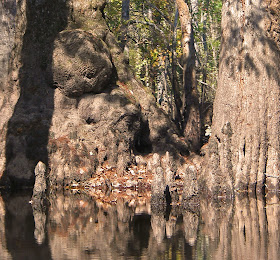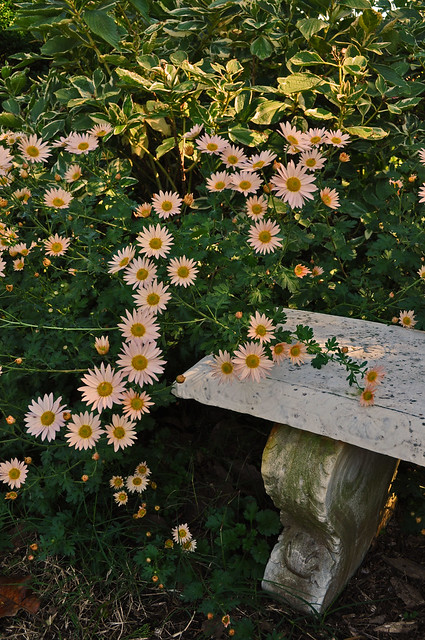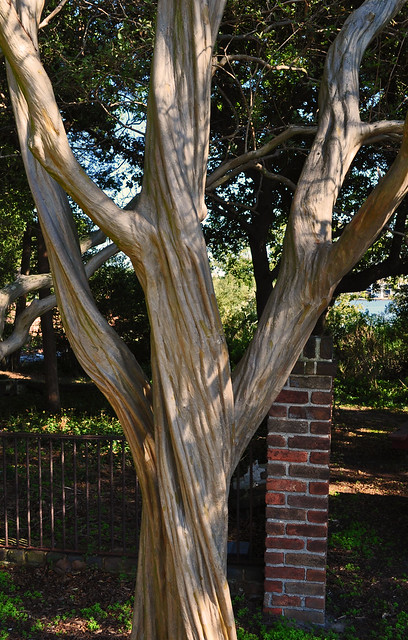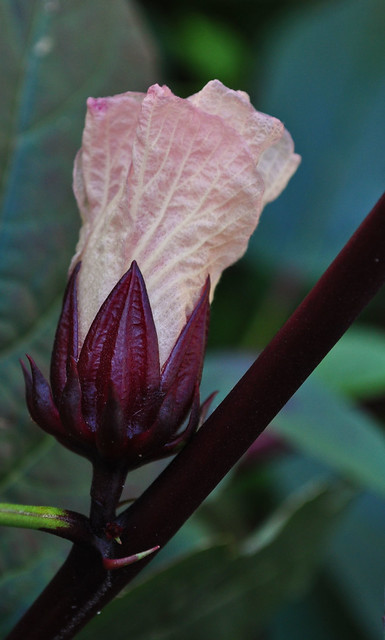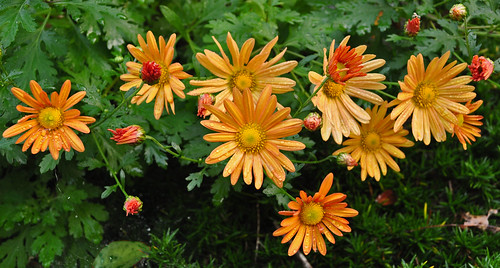The wind often kept her awake at night, words from the past echoing through the vacant rooms and through her head. A branch from the black walnut tree scraping against the bedroom window like her dead mother's screeching voice. Her mother's voice saying she was too fat, too slow. That seam was crooked, the cake dry, the floor not clean enough. Her mother's voice in praise of one sister's talent at the piano, and the other's beautiful hair, porcelain skin. The two brothers both clever and strong certain to make fine husbands. Her mother's voice telling her she would never marry and seeing to it that she didn't. A lifetime later her mother's voice calling out to collect the breakfast tray, calling out to change soiled sheets, calling out for her red pills.
October 31, 2011
October 29, 2011
Along the Nottoway
Last Saturday I took what will likely be one of my last kayak trips of the season. My destination was the Nottoway River in Southampton Co., Virginia, close to the North Carolina line. The Nottoway is a slow moving blackwater river that drains a good part of Southside Virginia. Blackwater refers to the distinctive dark, tea color of the water which is due to all of the leached tannins from surrounding trees. This part of the Nottoway flows through a bald cypress/tupelo swamp ecosystem, which were once very common along the coastal plain from Delaware south to Florida, west to Texas and up the Mississippi Valley. Unfortunately only about 1% of the original bald cypress/tupelo ecosystems remain in this country.

Near the landing I saw one power boat, but once past it I had the river to myself. In fact, for most of the time I felt like I had the whole planet to myself, which is a most precious feeling. I was awed by the trees along (and in) the river. Most were either bald cypress (Taxodium distichum) or one of two species of Tupelo (Nyssa aquatica and biflora), but there were other trees present including several species of oak and the common red maple (Acer rubrum). At certain places I could paddle between the trees and I felt like I was at the feet of giants. I was hoping to see some fall color from the water, but I think I was a week or two too early for the best show, though there was a good deal of red coming from Hawthorn (Crataegus) berries.

The river was mostly quiet except where a fallen tree here or there was snagged in the current or where a fish would jump. However, the woods were loud with birdsong, especially from belted kingfishers, who I would disturb and they would head further up the river bitching the whole time, only to have me catch up with them to start the whole process over again. Also keeping up a ruckus were the crows and hawks. Deeper upriver the water narrowed and I felt as if I was travelling on some small tributary of the Amazon, but reminded myself that this was not exotic and that there are still a few places like this much closer to home.

There will likely be a second part to this post next year. After I got back and was telling a friend about my trip, he told me how close I was to Cypress Bridge Natural Area and how to get there. Cypress bridge is home yo one of the only remaining tracts of virgin forest in the state, and its location has been deliberately kept vague. Within its borders are trees purported to be over a 1000 years old, including several champion trees, and it is also the final resting place of fabled Big Mama. The treehugger in me has an itch, and I will be back to scratch.

Near the landing I saw one power boat, but once past it I had the river to myself. In fact, for most of the time I felt like I had the whole planet to myself, which is a most precious feeling. I was awed by the trees along (and in) the river. Most were either bald cypress (Taxodium distichum) or one of two species of Tupelo (Nyssa aquatica and biflora), but there were other trees present including several species of oak and the common red maple (Acer rubrum). At certain places I could paddle between the trees and I felt like I was at the feet of giants. I was hoping to see some fall color from the water, but I think I was a week or two too early for the best show, though there was a good deal of red coming from Hawthorn (Crataegus) berries.

The river was mostly quiet except where a fallen tree here or there was snagged in the current or where a fish would jump. However, the woods were loud with birdsong, especially from belted kingfishers, who I would disturb and they would head further up the river bitching the whole time, only to have me catch up with them to start the whole process over again. Also keeping up a ruckus were the crows and hawks. Deeper upriver the water narrowed and I felt as if I was travelling on some small tributary of the Amazon, but reminded myself that this was not exotic and that there are still a few places like this much closer to home.

There will likely be a second part to this post next year. After I got back and was telling a friend about my trip, he told me how close I was to Cypress Bridge Natural Area and how to get there. Cypress bridge is home yo one of the only remaining tracts of virgin forest in the state, and its location has been deliberately kept vague. Within its borders are trees purported to be over a 1000 years old, including several champion trees, and it is also the final resting place of fabled Big Mama. The treehugger in me has an itch, and I will be back to scratch.
October 24, 2011
Little Green Apples
This month's Picture This Photo Contest from Gardening Gone Wild is about filling the frame. I didn't take any new pictures for the contest, but found three candidates from last year, all of them taken in the fall.
The first one was taken at a friend's garden, and I have been wanting to show it since I took it, but never got around to it. My original purpose was to get a shot of a plant I covet, Senna alata. However, when I enlarged the shot at home I was able to see how well the color from the Zinnias and Dahlias played with the Senna. I also liked how the summer flowers seem oblivious to the impending fall, whose colors are creeping in from the background landscape. In the end I decided not to submit this one as I was not sure it quite met the requirment to fill the frame.

My second choice was taken along the Great Dismal Swamp Canal in Chesapeake and has already been seen on this blog. The swamp's dark waters are famous and when still are a mirror reflecting anything above it. I thought this picture definately filled the frame, but I ended up picking another.

Perhaps it was the ghost of Roger Miller singing in my head, but this is my entry in the contest. I saw these fallen apples on the ground in varying states of decay where we camped in Shenandoah National Park. I was tickled with how the shot came out, it immediately reminded me of a painted still life of rotting fruit and I think it does fill the frame. The theme is similar to my entry into last month's contest, but I think this is a much better shot.

The first one was taken at a friend's garden, and I have been wanting to show it since I took it, but never got around to it. My original purpose was to get a shot of a plant I covet, Senna alata. However, when I enlarged the shot at home I was able to see how well the color from the Zinnias and Dahlias played with the Senna. I also liked how the summer flowers seem oblivious to the impending fall, whose colors are creeping in from the background landscape. In the end I decided not to submit this one as I was not sure it quite met the requirment to fill the frame.

My second choice was taken along the Great Dismal Swamp Canal in Chesapeake and has already been seen on this blog. The swamp's dark waters are famous and when still are a mirror reflecting anything above it. I thought this picture definately filled the frame, but I ended up picking another.

Perhaps it was the ghost of Roger Miller singing in my head, but this is my entry in the contest. I saw these fallen apples on the ground in varying states of decay where we camped in Shenandoah National Park. I was tickled with how the shot came out, it immediately reminded me of a painted still life of rotting fruit and I think it does fill the frame. The theme is similar to my entry into last month's contest, but I think this is a much better shot.

October 22, 2011
Better Than a Boardroom
Yesterday I attended an informal meeting at the Hermitage Museum and Gardens here in Norfolk. It was a beautiful day and at the last minute I opted to bike there instead of driving. I was meeting with a group of people from the Elizabeth River Project/River Star Homes, and we are trying to come up with ways to encourage people in the local watershed to maintain their lawns in a more environmentally, river-friendly manner. We are discussing such controversial issues as using less fertilizer, reducing turf area, planting white clover, creating rain gardens and shoreline buffers, switching from fescue to warm season grasses and other subversive topics. Our meeting was held at a picnic table in the garden by the river, and when it was over we got a tour of the Hermitage's new rain garden. After we said our goodbyes, I was able to wander through the gardens and enjoy the day. This is not this blog's first trip here, and if you want to take a trip back in time go here or here.

Blackberry Lily (Belamcanda chinensis)

Even if Crape Myrtles (Lagerstroemia) never flowered, I think I would grow them just to have trunks like this in the garden, talk about bones and structure!
I believe this is Boston Ivy (Parthenocissus tricuspidata) which is not native to Boston, but China, Japan and Korea.

Beyond the garden walls are the wilder parts of the Hermitage. There is a very successful living shoreline restoration project here. Faced with erosion from the Lafayette River, they decided several years ago to forgo bulkheading and riprap and instead opted for creating a living shoreline that not only prevents erosion, but creates (or more accurately re-creates) natural habitat.

One of my favorite unsung native shrubs is the Saltbush (Baccharis halimifolia). Regular readers may be tired of hearing about this plant, but it is sublime right now, ringing local shorelines with white clouds.
Osage Orange (Maclura pomifera) is not originally native to Virginia, but came from the southern plains. It makes a good projectile to lob at a sibling if you are so inclined. Thank you Mssrs. Lewis, Clark and Jefferson.
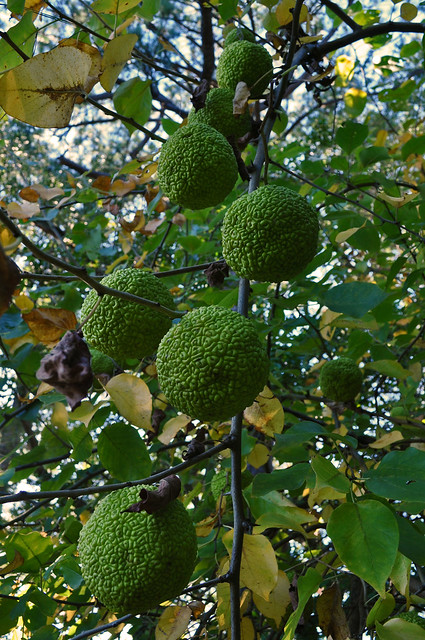
The wooded areas of the hermitage are scene to an epic battle of the invasives, including Privet (Ligustrum sinensis), English Ivy (Hedera helix) and the currently colorful, hometown favorite, Virginia Creeper (Parthenocissus quinquefolia).
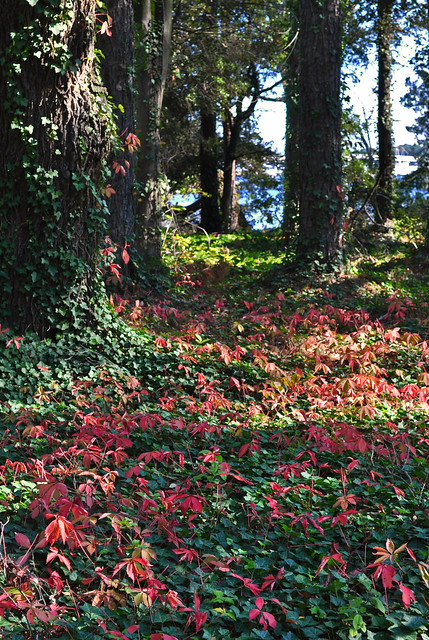


Blackberry Lily (Belamcanda chinensis)

Even if Crape Myrtles (Lagerstroemia) never flowered, I think I would grow them just to have trunks like this in the garden, talk about bones and structure!
I believe this is Boston Ivy (Parthenocissus tricuspidata) which is not native to Boston, but China, Japan and Korea.

Beyond the garden walls are the wilder parts of the Hermitage. There is a very successful living shoreline restoration project here. Faced with erosion from the Lafayette River, they decided several years ago to forgo bulkheading and riprap and instead opted for creating a living shoreline that not only prevents erosion, but creates (or more accurately re-creates) natural habitat.

One of my favorite unsung native shrubs is the Saltbush (Baccharis halimifolia). Regular readers may be tired of hearing about this plant, but it is sublime right now, ringing local shorelines with white clouds.
Osage Orange (Maclura pomifera) is not originally native to Virginia, but came from the southern plains. It makes a good projectile to lob at a sibling if you are so inclined. Thank you Mssrs. Lewis, Clark and Jefferson.

The wooded areas of the hermitage are scene to an epic battle of the invasives, including Privet (Ligustrum sinensis), English Ivy (Hedera helix) and the currently colorful, hometown favorite, Virginia Creeper (Parthenocissus quinquefolia).


October 15, 2011
Bloom Day: Easily Distracted
This month's Bloom Day finds me in grateful appreciation of one of the most entertaining falls I have enjoyed in a long time, but I am not talking about changing leaves, that has only been hinted at here. For one thing, I am talking about all the blooms in my garden right now. Normally by this point things look ragged and exhausted after fighting one of our summers. However, we had more than ample rain during August and September, followed by a spate of weather so nice it made my teeth hurt. Even on our bad weather days, we have been treated to skies more fascinating than television. A friend of mine was remarking on that last night, and she attributed the atmospheric show to global warming. I attributed it to just a greater appreciation of all things in general, that fortunately seems to be one the few benefits of our advancing age.
Let's distract ourselves from this discussion of age before it goes somewhere I don't want to, and let's head into the garden instead. My head has been turned all summer by the Zowie Zinnias (Zinnia elegans 'Zowie'). There have been blooms on them since the day they were planted way back in May.
That last picture introduced another plant I mentioned last month, Roselle Hibiscus (Hibiscus sabdariffa). Unlike the Zinnia, it has taken its sweet time to start blooming, but it is now in 5th gear. I am not normally a seed saver, but with this plant I will be making an exception.
Angelonia (Angelonia angustifolia) blossoms have held their mouths open in song all summer long, never asking much beyond a little water when they were putting down roots.
This summer I went to a garden party where plants were exchanged, and I came home with this Aloe, the species I don't know. I crashed an Aloe ID web site trying to look it up. Update: an anonymous commenter identified this as Haworthia limifolia. Thanks!
Our nicer weather has brought new life to the few roses I have. This is 'Hot Cocoa'.
Cuphea x 'David Verity' is listed as hardy for me, but even if it isn't, I will plant it again. Non-stop flowers all summer, and lately the foliage has begun to turn burgundy creating one of my favorite garden color combos with its orange flowers.
Another non-stop bloomer has been Cestrum aurantiaum 'Orange Zest'. This is my first year for this shrub and its second Bloom Day appearance.
I do have some more traditional fall bloomers to show starting with Mexican Bush Sage (Salvia leucantha), also seen last month.
Here is Toad Lily (Tricyrtis hirta), which is one of the most camera shy of perennials.
We will end this month's Bloom Day with my only hardy Chrysanthemum, Bolero (Dendranthemum 'Bolero'). I planted this last fall wanting to have a hardy Mum, but not being able to stomach the color or thuggish nature of Sheffields.
So what's entertaining and distracting you this fall; for what are you grateful? Share you answer with the on-line gardening world by taking part in Garden Bloggers Bloom Day, which is held on the 15th of each month. I am grateful for our GBBD hostess, Carol at May Dreams Gardens. Stop by and show her some love.
Let's distract ourselves from this discussion of age before it goes somewhere I don't want to, and let's head into the garden instead. My head has been turned all summer by the Zowie Zinnias (Zinnia elegans 'Zowie'). There have been blooms on them since the day they were planted way back in May.
That last picture introduced another plant I mentioned last month, Roselle Hibiscus (Hibiscus sabdariffa). Unlike the Zinnia, it has taken its sweet time to start blooming, but it is now in 5th gear. I am not normally a seed saver, but with this plant I will be making an exception.
Angelonia (Angelonia angustifolia) blossoms have held their mouths open in song all summer long, never asking much beyond a little water when they were putting down roots.
This summer I went to a garden party where plants were exchanged, and I came home with this Aloe, the species I don't know. I crashed an Aloe ID web site trying to look it up. Update: an anonymous commenter identified this as Haworthia limifolia. Thanks!
Our nicer weather has brought new life to the few roses I have. This is 'Hot Cocoa'.
Cuphea x 'David Verity' is listed as hardy for me, but even if it isn't, I will plant it again. Non-stop flowers all summer, and lately the foliage has begun to turn burgundy creating one of my favorite garden color combos with its orange flowers.
Another non-stop bloomer has been Cestrum aurantiaum 'Orange Zest'. This is my first year for this shrub and its second Bloom Day appearance.
I do have some more traditional fall bloomers to show starting with Mexican Bush Sage (Salvia leucantha), also seen last month.
Here is Toad Lily (Tricyrtis hirta), which is one of the most camera shy of perennials.
We will end this month's Bloom Day with my only hardy Chrysanthemum, Bolero (Dendranthemum 'Bolero'). I planted this last fall wanting to have a hardy Mum, but not being able to stomach the color or thuggish nature of Sheffields.
So what's entertaining and distracting you this fall; for what are you grateful? Share you answer with the on-line gardening world by taking part in Garden Bloggers Bloom Day, which is held on the 15th of each month. I am grateful for our GBBD hostess, Carol at May Dreams Gardens. Stop by and show her some love.
October 14, 2011
Windsor Castle
One of the newest parks in this area is Windsor Castle Park in the town of Smithfield. It takes its name from the plantation house which anchors the park. The first European to own the property was Arthur Smith who patented the land in 1637, and it was his grandson, Arthur Smith III, who donated a few acres to establish the town of Smithfield. Sometime in the mid 1700's the current house was built, but has been remodeled several times over the centuries. It is a typical Tidewater plantation with the main house facing the water showing off the money side, as most guests always arrived by boat. There are several dependencies of varying ages still intact on the property including a kitchen house, smokehouse, barns, a log corncrib, graneries and others.
The town of Smithfield was built on pork and is home to the iconic ham the bears the town's name. It's a great place to live (unless you're a pig), with a vital downtown, historic architecture, galleries, restuarants, shops, good schools, marinas, all surrounded by the natural beauty of creeks, rivers and marshes. At one point the several hundred acres that make up Windsor Castle were for sale, and looked destined to be turned into a vast development of the "new urbanism" style. However, Smithfield is not urban, but a thriving small town that already has a vibrant Main St. In a twist on the Smith's original gift, in steps Joeseph Luter III, founder and former CEO of Smithfield Foods, who drops first $5,000,000 then another $2,000,000 to buy Windsor Castle and 200 acres of its original land. Luter did so to save the land and create a park for the town of Smithfield. Today the park is still rather raw looking but already has walking trails, lots of newly planted trees, a path for mountain bikes, a fishing pier, a dog park, a fruit orchard and the sweetest kayak launch on Cypress Creek, which is why I was there.
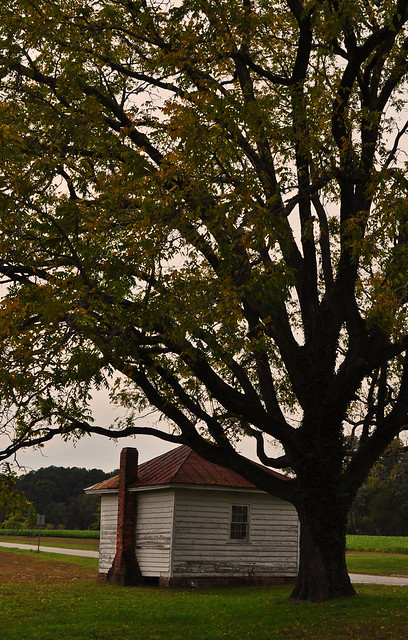

The town of Smithfield was built on pork and is home to the iconic ham the bears the town's name. It's a great place to live (unless you're a pig), with a vital downtown, historic architecture, galleries, restuarants, shops, good schools, marinas, all surrounded by the natural beauty of creeks, rivers and marshes. At one point the several hundred acres that make up Windsor Castle were for sale, and looked destined to be turned into a vast development of the "new urbanism" style. However, Smithfield is not urban, but a thriving small town that already has a vibrant Main St. In a twist on the Smith's original gift, in steps Joeseph Luter III, founder and former CEO of Smithfield Foods, who drops first $5,000,000 then another $2,000,000 to buy Windsor Castle and 200 acres of its original land. Luter did so to save the land and create a park for the town of Smithfield. Today the park is still rather raw looking but already has walking trails, lots of newly planted trees, a path for mountain bikes, a fishing pier, a dog park, a fruit orchard and the sweetest kayak launch on Cypress Creek, which is why I was there.





